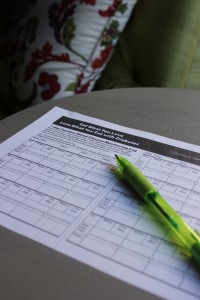 Your blood glucose (blood sugar) is a powerful tool. Using a blood glucose log will help you become aware of how eating, physical activity, and other factors affect your diabetes.
Your blood glucose (blood sugar) is a powerful tool. Using a blood glucose log will help you become aware of how eating, physical activity, and other factors affect your diabetes.
For many people, the idea of checking their blood sugar is simply overwhelming. Becoming curious about your blood glucose levels is an important shift toward taking charge of your health and reducing the stress associated with managing your diabetes. If you are not checking your blood sugar regularly and you are willing to give it a try, conduct a one-week experiment to see what you can learn. Here’s a great way to learn how to use a blood glucose log:
- Download the 7-Day Fearless Blood Glucose Log, use one your health care team provides, or explore blood glucose tracking tools to use on your computer or smartphone. (Take a look at the sample on page 57 of Eat What You Love, Love What You Eat with Diabetes.)
- Test and record your blood glucose twice a day for the next seven days (a total of 14 blood glucose tests).
- Test your blood glucose before a meal or two hours after a meal, or both. Paired glucose testing, which is blood glucose testing right before and two hours after eating, offers a lot of information, which we’ll explore further later.
- Also check your blood glucose when you think it might be low and when you think you may have eaten too much. Remember, the purpose is to help you learn and care for yourself, not to cause blame, shame, or guilt.
- Jot down your hunger and fullness levels as well as notes about other physical sensations, your meal, physical activity, and anything else you think might help you understand your blood sugar levels.
On Target
Now let’s take a look at your blood glucose log and try to interpret the testing to more fully understand your diabetes, beginning with figuring out how often your blood glucose levels are in the target range. If you have prediabetes, your target is normal blood glucose:
- Fasting (nothing to eat for eight hours) or before meals: <100 mg/dL
- Two hours after eating: <140 mg/dL
If you’ve been diagnosed with Type 2 diabetes, your target blood glucose levels are:
- Fasting (nothing to eat for eight hours) or before meals: 70 to 130 mg/dL
- Two hours after eating: <180 mg/dL
(Check with your health care provider to confirm that these are the right targets for you.)
What do I do with my blood glucose tests?
Use your blood glucose log to see what percentage of time you are in your target range and look for opportunities for improvement. Here’s how:
- Review your log and circle all of the blood glucose readings that are within these target ranges. Next count all the blood glucose tests you took. We suggested 14 tests; it’s fine if you tested a different number of times.
- Divide the number of blood glucose levels that were in your target range by the total number of tests you took. For example: six tests in your target range divided by 14 total tests equals 43 percent of your target.
- Place an “X” over blood glucose levels that are less than 70 mg/dL; these are episodes of hypoglycemia. Count the number of episodes of hypoglycemia; call your health care provider if you have two or more episodes of hypoglycemia in one week.
As you review your blood glucose readings, be aware of any judgment that arises and try to let it go. It isn’t realistic to expect 100 percent of your blood glucose levels to be in your target range. As you learn to work with the variables, shoot for 50 to 65 percent; anything above that is even better (Brewer et al. 1998). If you find that the percent of blood sugars that are in target is less than 50 percent, look for lifestyle opportunities, such as changes in diet, activity, or stress. If those changes are not possible, contact your health provider to explore other options.
